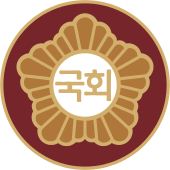South Korean legislative election, 2012
| | |||||||||||||||||||||||||||||||||||||||||||||||||||||||||||||||||||||||||||||||||||||||||||||||||
| |||||||||||||||||||||||||||||||||||||||||||||||||||||||||||||||||||||||||||||||||||||||||||||||||
| |||||||||||||||||||||||||||||||||||||||||||||||||||||||||||||||||||||||||||||||||||||||||||||||||
|
| |||||||||||||||||||||||||||||||||||||||||||||||||||||||||||||||||||||||||||||||||||||||||||||||||
| Red represented to Saenuri, Yellow represented to DUP, Purple represented to UPP, Blue represented to LFP. | |||||||||||||||||||||||||||||||||||||||||||||||||||||||||||||||||||||||||||||||||||||||||||||||||
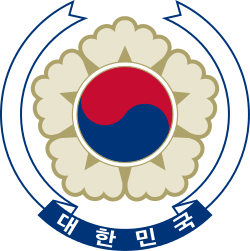 |
| This article is part of a series on the politics and government of South Korea |
| Constitution |
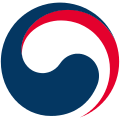
|
|
Judiciary 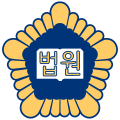
|
The legislative election for the 19th National Assembly was held in South Korea on 11 April 2012. The election was won by the ruling Saenuri or New Frontier Party, which renewed its majority in the National Assembly,[1] despite losing seats. The election has been read as a bellwether for the presidential election to be held later in the year.[2] The result confounded exit polls and media analysis which had predicted a closer outcome.[3]
Background
The South Korean National Assembly consists of 246 directly elected seats and 54 nationwide proportional representation seats chosen under an FPTP-PR parallel voting system.[4] In South Korea's presidential system, the head of state chooses the cabinet, but the loss of control in the parliament could have hampered President Lee's government substantially.[5]
Parties and coalitions
Four parties won seats in the 2012 election:
- Saenuri Party (Korean: 새누리당, Saenuri-dang), led by Park Geun-hye.[6]
The largest conservative party and incumbent government. Formerly name the Grand National Party,[7] the party was renamed in February after a period of internal crisis in which an Emergency Response Commission assumed control of the party.[8][9] - Democratic United Party (Korean: 민주통합당, Minju Tonghap-dang), led by Han Myeong-sook. The largest liberal party and principal opposition.[10][11]
- Liberty Forward Party (Korean: 자유선진당, Jayu Seonjin-dang), led by Sim Dae-pyung. The second-largest conservative party with its primary support base in Chungcheong.[12]
- Unified Progressive Party (Korean: 통합진보당, Tonghap Jinbo-dang), led jointly by Rhyu Si-min, Lee Jung-hee, and Sim Sang-jeong.[13] The largest left-progressive party.[14][15]
Other parties that put forward candidates included the left-wing New Progressive Party and the centre-right Korea Vision Party.
The conservative parties were fragmented, particularly between Saenuri and the new KVP over the latter recruiting high-profile defected members of the incumbent party and those who were denied tickets in the election, which was also reflective of a division grew between Park's leadership and loyalists of Lee Myung-bak.[16] However, the DUP–UPP coalition also came under strain due to irregularities in the UPP's primaries that involved co-leader Lee Jung-hee.[17]
Campaign
Campaigning for the election officially began on 29 March, though party leaders toured the country beforehand to rally support for their bids.[18] The international media suggested that the main issues in the campaign were economic, including inflation, educational and housing costs, unemployment and underemployment, the income gap, and social welfare, while the North Korean issue did not play a role.[2][7]
The opposition DUP tried to harness discontent with the incumbent Lee's administration, and called on the electorate to adjudge the election as a referendum on Lee's presidency.[19] The opposition coalition endeavored to depict the ruling party as unsocial and favoring the rich, while promising to create jobs.[20] The incumbent government emphasised the threat of North Korea and made the case for continuing their hard line towards the northern neighbour and maintaining a close alliance with the United States. They accused the opposition of jeopardising the free trade agreement with the U.S. The DUP had demanded renegotiation of the treaty and threatened to cancel it in case of the United States' refusal to negotiate.[19]
The international media highlighted the candidacy of Cho Myung-chul, a professor who defected from North Korea in 1994.[21][22] In its newspaper Rodong Sinmun, the North Korean Workers' Party called on the electorate to vote out the incumbent government: "Young voters, students and people must deliver a crushing defeat to the traitors."[1]
Scandals
After accusations of unauthorized government surveillance surfaced, legislators called for an investigation, while the ruling party accused the previous government of doing the same.[2] The presidential office published an analysis stating that 84% of the recorded incidents had taken place under the previous administration of Roh Moo-hyun.[23] A post-election analysis by polling institute Realmeter showed that the ruling party's handling of scandal was effective, and that the surveillance scandal didn't affect voters' decision much.[24] A DUP candidate, Kim Yong-min, was also accused of having made numerous offensive comments on the podcast-talk-show Naneun Ggomsuda,[25] for which he apologized but refused to rescind his candidacy, despite the DUP leadership advising him to do so.[26][27] Kim subsequently failed to win his seat in the election.[28]
Opinion polling
Polls were barred in the final week of the election, just before indications suggested the two largest parties would get somewhere between 130–135 seats each. A high tunout, particularly with the youth, was seen as beneficial to the opposition.[2]
| Institute | Date | Saenuri (NFP) |
Democratic United (DUP) |
Unified Progressive (UPP) |
Liberty Forward (LFP) |
Korea Vision (KVP) |
New Progressive (NPP) |
|---|---|---|---|---|---|---|---|
| Realmeter[29][30] | 23 December 2011 | 31.2% | 30.9% | 6.1% | 2.2% | – | 1.3% |
| Realmeter[31] | 13 January 2012 | 29.5% | 34.7% | 3.2% | 2.4% | – | 1.8% |
| Realmeter[32] | Jan.25–27, 2012 | 30.3% | 37.1% | 4.0% | 2.0% | – | 1.0% |
| Realmeter[32] | Jan.30–Feb.2, 2012 | 32.9% | 36.9% | 3.9% | 1.5% | – | 0.9% |
| Realmeter[32] | Feb.6–10, 2012 | 33.9% | 35.8% | 4.2% | 2.4% | – | 0.8% |
| Hankyoreh / KSOI[33] | Feb.24–25, 2012 | 38.2% | 32.9% | 3.1% | 1.7% | 1.5% | 1.1% |
| Realmeter[32] | Feb.27–Mar.2, 2012 | 36.3% | 36.3% | 6.1% | 1.7% | 0.4% | – |
| Realmeter[32] | 5–9 March 2012 | 40.3% | 32.7% | 4.8% | 2.3% | – | – |
| KBS[34][nb 2] | 10–11 March 2012 | 34.1% | 35.4% | 3.6% | 1.7% | – | – |
| Realmeter[32] | 12–16 March 2012 | 39.4% | 33.7% | 5.7% | 2.3% | – | – |
| Realmeter[32] | 19–23 March 2012 | 37.4% | 33.3% | 7.5% | 2.1% | – | – |
| Realmeter[35] | 26–30 March 2012 | 39.8% | 30.5% | 8.1% | 2.3% | – | – |
| Realmeter[36][nb 3] | 28 March 2012 | 37.8% | 30.5% | 12.1% | 2.3% | 1.9% | 1.6% |
| Hankyoreh / KSOI[37] | 31 March 2012 | 38.3% | 33.5% | 7.2% | 2.4% | 0.3% | 1.0% |
| Research View[38] | 1 April 2012 | 42.3% | 29.5% | 9.7% | 3.9% | 1.1% | 2.1% |
Results
The voting centres were open from 6:00−18:00. Voting occurred via electronic ballot counting and scanning that gave an instantaneous result.[6] Cho Myung-chul's successful candidature was the first time that one of the 23 thousand North Korean refugees living in the South was elected to the National Assembly.[21]
| ↓ | ||||
| |
|
|
| |
*Independents
**Progressives
| Turnout 54.3% | |||||||||||
|---|---|---|---|---|---|---|---|---|---|---|---|
| Parties | Local seats | ± | Block seats | ± | Constituency votes | % | PR block votes | % | Total seats | ± | |
| Saenuri Party (새누리당) (NFP) 1 | 127 | -10 | 25 | -5 | 9,324,911 | 43.3% | 9,130,651 | 42.8% | 152 | -15 | |
| Democratic United Party (민주통합당) (DUP) | 106 | +40 | 21 | +6 | 8,156,045 | 37.9% | 7,777,123 | 36.5% | 127 | +46 | |
| Unified Progressive Party (통합진보당) (UPP) | 7 | +5 | 6 | +3 | 1,291,306 | 6.0% | 2,198,405 | 10.3% | 13 | +8 | |
| Liberty Forward Party (자유선진당) (LFP) | 3 | -11 | 2 | -2 | 474,001 | 2.2% | 690,754 | 3.2% | 5 | -13 | |
| New Progressive Party (진보신당) (NPP) | 0 | ±0 | 0 | ±0 | 101,614 | 0.5% | 243,065 | 1.1% | 0 | ±0 | |
| Korea Vision Party (국민생각) (KVP) | 0 | ±0 | 0 | ±0 | 44,379 | 0.2% | 156,241 | 0.7% | 0 | ±0 | |
| Creative Korea Party (창조한국당) (CKP) | 0 | -1 | 0 | -2 | 3,624 | 0.0% | 91,935 | 0.4% | 0 | -3 | |
| Other parties | 0 | ±0 | 0 | ±0 | 132,709 | 0.6% | 1,043,887 | 5.0% | 0 | ±0 | |
| Independents | 3 | -22 | — | — | 2,016,737 | 9.4% | — | — | 3 | -22 | |
| Total | 246 | 54 | 21,545,326 | 100.0% | 21,332,061 | 100.0% | 300 | ||||
| Ideology | |||||||||||
| Conservative (NFP, LFP, KVP) | 130 | -21 | 27 | -7 | 9,843,291 | 45.7% | 9,977,646 | 46.7% | 157 | -28 | |
| Liberal (DUP, CKP) | 106 | +39 | 21 | +4 | 8,159,669 | 37.9% | 7,869,058 | 36.9% | 127 | +43 | |
| Progressive (UPP, NPP) | 7 | +5 | 6 | +3 | 1,392,920 | 6.5% | 2,441,470 | 11.4% | 13 | +8 | |
| Total | 246 | 54 | 19,395,880 | 90.1% | 20,288,174 | 95.0% | 300 | ||||
1 Comparison includes members elected in 2008 for the Pro-Park Coalition
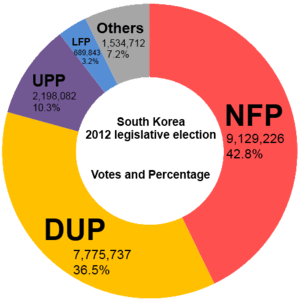
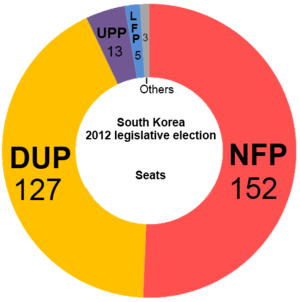
Regional variations

The result showed considerable regional variations. The DUP and its coalition partner the UPP made significant gains in the north-west of the country, winning a combined total of 26 new seats in Seoul, four in Incheon and 14 in suburban Gyeonggi-do. Altogether the DUP-UPP coalition won 70 of 112 seats in this region, a gain of 44. They also maintained their dominant position in Jeolla and Jeju, winning 31 of 33 seats, a gain of three. Had the liberal parties made comparable gains in the eastern half of the country, they would have won the election. They won only 13 seats of 100 in these provinces, a net gain of one. In Chungcheong, Gangwon and Gyeongsang, the Saenuri Party made gains from the DUP and the Liberty Forward Party. The liberal parties failed to make significant gains in the southeast, a traditionally conservative region.[44] The Saenuri Party also took seats from independent members across the country.[45]
| |Region | Saenuri | +/- | DUP | +/- | UPP | +/- | LFP | +/- | CKP | +/- | Indep. | +/- | Total | +/- |
|---|---|---|---|---|---|---|---|---|---|---|---|---|---|---|
| Seoul | 16 | - 24 | 30 | + 21 | 2 | + 2 | 0 | - | 0 | - 1 | 0 | - | 48 | - |
| Busan | 16 | + 4 | 2 | + 1 | 0 | - | 0 | - | 0 | - | 0 | - 5 | 18 | - |
| Incheon | 6 | - 3 | 6 | + 4 | 0 | - | 0 | - | 0 | - | 0 | - 1 | 12 | - |
| Daegu | 12 | + 1 | 0 | - | 0 | - | 0 | - | 0 | - | 0 | - 1 | 12 | - |
| Gwangju | 0 | - | 6 | - 1 | 1 | + 1 | 0 | - | 0 | - | 1 | - | 8 | - |
| Daejeon | 3 | + 3 | 3 | + 2 | 0 | - | 0 | - 5 | 0 | - | 0 | - | 6 | - |
| Ulsan | 6 | + 1 | 0 | - | 0 | - | 0 | - | 0 | - | 0 | - 1 | 6 | - |
| Gangwon | 9 | + 6 | 0 | - 2 | 0 | - | 0 | - | 0 | - | 0 | - 3 | 9 | + 1 |
| Gyeonggi | 21 | - 12 | 29 | + 12 | 2 | + 2 | 0 | - | 0 | - | 0 | - 1 | 52 | + 1 |
| South Gyeongsang | 14 | + 1 | 1 | - | 0 | - 2 | 0 | - | 0 | - | 1 | - | 16 | - 1 |
| North Gyeongsang | 15 | + 5 | 0 | - | 0 | - | 0 | - | 0 | - | 0 | - 5 | 15 | - |
| South Jeolla | 0 | - | 10 | + 1 | 1 | + 1 | 0 | - | 0 | - | 0 | - 3 | 11 | - 1 |
| North Jeolla | 0 | - | 9 | - | 1 | + 1 | 0 | - | 0 | - | 1 | - 1 | 11 | - |
| South Chungcheong | 4 | + 4 | 3 | + 2 | 0 | - | 3 | - 5 | 0 | - | 0 | - 1 | 10 | - |
| North Chungcheong | 5 | + 4 | 3 | - 3 | 0 | - | 0 | - 1 | 0 | - | 0 | - | 8 | - |
| Jeju | 0 | - | 3 | - | 0 | - | 0 | - | 0 | - | 0 | - | 3 | - |
| Sejong | 0 | - | 1 | + 1 | 0 | - | 0 | - | 0 | - | 0 | - | 1 | + 1 |
| Proportional representation |
25 | - 5 | 21 | + 6 | 6 | + 3 | 2 | - 2 | 0 | - 2 | 0 | - | 54 | - |
| Total | 152 | - 15 | 127 | + 46 | 13 | + 8 | 5 | - 13 | 0 | - 3 | 3 | - 22 | 300 | + 1 |
Reactions and aftermath
President Lee said that the "people made wise choices. The government will do its best to manage state affairs in a stable manner and take care of the people's livelihood". The DUP's secretary-general Park Sun-sook conceded the election and added: "The DUP failed to turn public calls for punishing the ... ruling party into reality. We apologise for disappointing supporters. We will sincerely think over what today's election means and try ceaselessly to be reborn as a party the people can lean and rely on."[1] Sim Dae-pyung, leader of the Liberty Forward Party, announced his resignation after the party's poor performance.[46]
On 13 April, the DUP leader Han Myeong-sook announced her resignation on account of her party's defeat.[47]
Notes
- 1.^ Comparison includes the Pro-Park Coalition, which split from and subsequently reintegrated with the Grand National Party.
- 2.^ This survey asked separate questions on party support and voting intention. The latter result is reported here.
- 3.^ This survey dealt specifically with seats allocated by proportional representation.
External links
References
- 1 2 3 "S. Korea's ruling party pulls off upset victory in crucial general elections". Yonhap News Agency. 11 April 2012. Retrieved 11 April 2012.
- 1 2 3 4 "South Korea votes in closely contested poll". Al Jazeera English. 11 April 2012. Retrieved 13 April 2012.
- ↑ Odds & Ends A Day After The Election. Wall Street Journal, 12 April 2012. Retrieved 15 April 2012.
- ↑ Hong Yeong-rim(홍영림) (9 April 2012). "(총선 D-2) 비례대표 의석(총 54석) 전망도 새누리·민주 초박빙" [(Election D-2) Block seat (total 54 seats) prediction: NFP and DUP are neck in neck.]. Chosun Ilbo (in Korean). Retrieved 13 April 2012.
- ↑ Yoon, Sangwon (11 April 2012), "S. Korea Ruling Party Risks Election Loss", Bloomberg Businessweek
- 1 2 Harry Fawcett (12 April 2012). "A tale of two Koreas". Al Jazeera Blogs. Retrieved 15 April 2012.
- 1 2 The South: Busy at the polls. Asia Times, 2 April 2012. Retrieved 11 April 2012.
- ↑ Ruling party`s emergency committee. Donga Ilbo, 17 December 2011. Retrieved 12 April 2012.
- ↑ Rebranding GNP picks Saenuri as new name. Korea Joongang Daily, 3 February 2012. Retrieved 12 April 2012.
- ↑ South Korea's ruling party holds on to parliament. BBC News, 12 April 2012. Retrieved 12 April 2012.
- ↑ Left-wing alliance a double-edged sword for main opposition. The Korea Herald, 12 April 2012. Retrieved 12 April 2012.
- ↑ D-6: Election Race Outside Capital Region. Arirang News, 11 April 2012. Retrieved 11 April 2012.
- ↑ Will the UPP candidates stack up?. Korea Joongang Daily, 1 March 2012. Retrieved 12 April 2012.
- ↑ Hur Woo(허우) (April 2012). 종북좌파세력 국회진출 저지 국민연대 [Conservatives should united against the pro-North faction]. All-in Korea (in Korean). Retrieved 12 April 2012.
- ↑ Lee Tae-hoon (12 April 2012). "Alliance benefits leftist party most". The Korea Herald. Retrieved 13 April 2012.
The minor opposition United Progressive Party (UPP) won 13 seats ... elevating its status as the third largest parliamentary group.
- ↑ Signs of conservatives’ division deepen, Korea Herald. 23 March 2012.
- ↑ Rift growing in opposition alliance, Korea Herald. Retrieved 23 March 2012.
- ↑ Party Leaders Rally Support Ahead of Official Campaign. KBS, 26 March 2012. Retrieved 2 April 2012.
- 1 2 Choe, Sang-hun (11 April 2012), "South Koreans Vote in Parliamentary Elections", New York Times
- ↑ "Polls open in S Korean election", Sky News, 11 April 2012
- 1 2 Hancocks, Paula (11 April 2012), "North Korean defector stands for South Korean election", CNN
- ↑ Lim, Yun Suk (11 April 2012), "South Korea set to elect first defector lawmaker", Channel News Asia
- ↑ Exploitation of illegal surveillance scandal. Donga Ilbo, 2 April 2012. Retrieved 24 April 2012.
- ↑ 여론조사 공표금지 기간 전후, 총선 다큐멘터리 10일. Realmeter, 23 April 2012. Retrieved 25 April 2012.
- ↑ Lee, Tae-hoon (8 April 2012). "'Bad-boy' hopeful refuses to bow out". The Korea times. Retrieved 12 April 2012.
- ↑ Park Si-soo (4 May 2012). "Foul-mouthed podcaster hangs on to candidacy". The Korea Times. Retrieved 13 April 2012.
- ↑ Lee Sun-young (8 April 2012). "Disgraced candidate vows to finish race". The Korea Herald. Retrieved 13 April 2012.
- ↑ "Kim's mouth cost him election". JoongAng Daily. 13 April 2012. Retrieved 13 April 2012.
- ↑ "(Realmeter poll) NFP 31.2%-DUP 30.9%-UPP 6.1%". Realmeter (in Korean). 26 December 2011. Retrieved 13 April 2012.
- ↑ "박근혜, 대선 다자대결 구도서 27.1%로 1위(NFP leader Park Geun Hye ranked first with 27.1% popularity in a poll)". JoongAng Daily (in Korean). 2011-12-26. Retrieved 13 April 2012.
- ↑ Son Bong-seok (손봉석) (16 January 2012). "문재인, 여론조사서 지지율 14.6%로 올라" [Moon Jae-in's popularity soared at 14.6%]. The Kyunghyang Shinmun. Retrieved 14 April 2012.
- 1 2 3 4 5 6 7 Realmeter.net. Realmeter.
- ↑ Andy Jackson (28 February 2012). "South Korean conservatives show renewed strength ahead of April elections". Asiancorrespondent.com. Retrieved 6 March 2012.
When asked which party they would vote for in the April 11 general election, 38.2% of respondents said the SP, and 32.9% that they would vote for the DUP. These were followed by the Unified Progressive Party with 3.1%, the Liberty Forward Party with 1.7%, K Party with 1.5% and the New Progressive Party with 1.1%.
- ↑ "KBS Survey: NFP, DUP in Close Contest in Approval Ratings". Korean Broadcasting System. 13 March 2012. Retrieved 13 April 2012.
- ↑ 핵안보 정상회담으로 당청 지지율 반등 [Nuclear Security Summit boosted ruling party's approval rate] (in Korean). 2 April 2012. Retrieved 13 April 2012.
- ↑ "비례대표 정당지지, 새누리 38%, 민주 31%, 통진 12%" [Party poll: Saenuri 38%, DUP 31%, UPP 12%]. 29 March 2012. Retrieved 13 April 2012.
- ↑ Son Won-je (2 April 2012). "Opposition makes slight comeback in general election advance poll". The Hankyoreh. Retrieved 13 April 2012.
- ↑ Kim Dang (2 April 2012). 투표의향, 새누리당 41.5%-야권단일 37.5%-기타 7.6%. 비례대표, 새누리 27 민주 18 통합진보 6 선진 2석 [Which party will you support in the election? NFP 41.5%, DUP-UPP coalition 37.5%, others 7.6%. Block seats: NFP 27, DUP 18, UPP 6, LFP 2]. Ohmynews (in Korean). Retrieved 13 April 2012.
- ↑ Number of Local seats earned by each party (in Korean), National Election Commission, Retrieved 12 April 2012.
- ↑ Number of Block seats earned by each party (in Korean), National Election Commission, Retrieved 12 April 2012
- ↑ Total number of votes earned for Block seats by each party (in Korean), National Election Commission, Retrieved 12 April 2012
- ↑ Chang Se-hoon(장세훈) (April 14, 2012). "과반의석? 박근혜 긴장 늦추지 못하는 이유는" [Winning majority? Why Park Geun-hye can't be too cheerful about the election.]. 서울신문 (in Korean). Retrieved April 14, 2012.
- ↑ News 1 (April 13, 2012). "총선 결과, 보수-진보 의석수 158 대 142, 정당 득표 997만 대 982만. 박빙 대선 레이스 예고" [Election results, conservatives vs liberals: seats 158 vs. 142, total votes 9.97mil. vs. 9.82mi. President election will be a close call.] (in Korean). JoongAng daily. Retrieved April 13, 2012.
- ↑ Armstrong, C. K. (2007) Korean Society: Civil Society, Democracy and the State. Taylor & Francis, p. 4.
- ↑ See regional tables at Psephos: Adam Carr's election archive
- ↑ "Ruling party leader pledges new beginning after election win". YONHAP NEWS. 12 April 2012. Retrieved 15 April 2012.
- ↑ "Opposition leader steps down over election defeat". The Korea Times. 2012-04-13. Retrieved 2012-04-13.
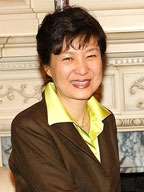
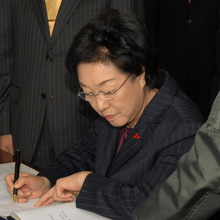
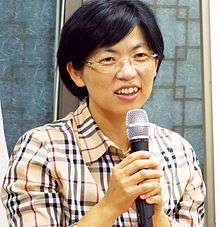
.svg.png)
